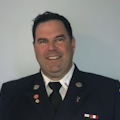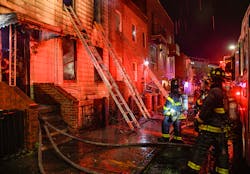Although this generally is a truck company-focused column, I ask that you indulge me with this edition regarding something that affects all of us who are in the fire service: the mayday.
Reject the reluctance
We hope that we all make it through our career without having to call—or even be involved in—maydays. The reality is that they happen all too often.
There seems to be a stigma with calling the mayday: Firefighters wait too long to call, because they can’t swallow their pride and admit that they are in trouble. For your sake, for your family’s sake and for your crew’s sake, you must ignore the stigma and call for help when you believe that you are in trouble.
I called a mayday twice in my career. I was fortunate that they weren’t for me. One was a legitimate mayday, and we removed a downed firefighter from the structure. I canceled the other mayday soon after I called it: After contacting the firefighter, I realized that he just needed a bit of help getting out of a small hole.
After the mayday
What are the circumstances that might require you to call a mayday? Obviously, there are too many to list in the space constraints of this column, but it’s particularly important to cover a few here: a traumatic fire event that leaves you in a situation where collapse is imminent or already occurred; you or a member get lost or turned around in the structure; you come across an unconscious firefighter; and a firefighter is in a life-threatening situation.
Regarding “traumatic fire events,” there are countless instances where some type of traumatic fire event takes place—backdraft, smoke explosions, flashovers, etc. Depending on where crews are operating at the time, this can leave one or more members of the crew in a bad way.
As for “lost or turned around,” in immediately dangerous to life and health, or IDLH, environments, you can lose most of your senses, which makes it very easy to lose your way. In this instance, lost firefighters should be careful to conserve their air. Many times, it’s best to stay put and to wait for other crewmembers who are in the area to come to help you. In addition to calling the mayday, it might help to call out and/or to strike a tool to make some noise to signal to members who are coming to assist you. Obviously, you can sound your pass-device, although that might hinder further radio communications. An often-overlooked tip is to hold your breath and listen for rigs or running tools that can point you back in the right direction.
As noted, the list here can go on, but the point is, if you’re lost and not injured or trapped, you can take simple steps to assist in your rescue or even get yourself out.
LUNAR or WWW
I recently had the privilege of teaching mayday and firefighter survival at conferences. This allowed me to work with some excellent instructors from other departments, which provided me the opportunity to pick up some great tips and a new perspective on things when it comes to maydays.
I recently did an Instagram poll of my 1,400 followers about maydays for research for this column. (Although I certainly am not what you’d call a social media influencer, I follow many who are, and I value their opinion.) The poll asked which of two acronyms users prefer for the mayday call. I listed the two that I believe are the most common: LUNAR—for Location, Unit, Name, Assignment, Resources needed—and WWW—for Who, What, Where, or who you are, what you need and where you are. Both of these are simple and to the point, for sure.
The second part of my Instagram post was a question: Do you add a locator phrase?
The results were mixed. About 60 percent of respondents said that they use the LUNAR acronym.
Answers to the locator phrase varied, including several versions of the mayday acronyms. Some respondents asked, “What is a locator phrase?”
This very unscientific study indicates that the fire service can be mixed about how to call a mayday. The lack of votes or positive answers for the locator phrase showed me that I must address it and get the idea out there.
Adding the locator phrase
Several months back, I was preparing a lesson plan for my department’s survival and mayday station with friend and mentor Lt. Jason Erban (Ret.). He mentioned adding the locator phrase to the mayday transmission. I never heard of this. Instead, I would add the locator phrase after completing the transmission. The difference is seconds, but precious seconds, no doubt.
As our conversation went on, we discussed the “why” behind adding the locator phrase to the transmission, and I was sold. I will teach it to anyone who will listen going forward.
The locator phrase is this simple: Mayday! Mayday! (insert location here) Mayday!
The incredible amount of research that’s been conducted by Project Mayday and the like proves that companies that are around mayday firefighters can make—and have made—a huge difference in the outcome. That’s why it’s critical to say who and where early in the mayday call. I transmit, “Mayday! Mayday! Second floor! Mayday! Captain Eagen Truck 7. Turned around on the second floor. Need help finding my way out.”
The advantage of saying the name that my parents gave me early in the call and adding the locator phrase should indicate to the firefighter who I bumped into in the hallway 30 seconds before that I can’t be far away or I probably am turned around in that strange closet that he/she was just in.
The members who are in the area can make a quick assist, and we can cancel the mayday and continue the operation.
This obviously is a perfect world situation, but even if it’s a more complex incident that requires additional time or resources, having a good idea of where the downed firefighter is in the structure saves a significant amount of time and, potentially, saves the firefighter’s life.
Train
Your first mayday shouldn’t be the first time that you call one. You must train on maydays, and you must do so often. Not only must you train on calling a mayday, but you must practice your survival skills as well. In some circumstances, your only option might be self-rescue.
Priority should be given to setting up egress ladders at windows when crews operate on upper floors. Even in situations that involve low staffing, incident commanders still must make egress ladders a priority. Crews that operate inside of the structure can do so with more confidence when they know that most windows have a ladder for egress for them.
Something to drill on as far as self-rescue skills: headfirst using the hook two, reach three technique. This is quick and easy and allows you to transition and come down the ladder feet first once you are out of harm’s way.
Depending on local statutes, many firefighters are issued personal escape systems, or they wear one that they purchased themselves. These are a great safety net, but take the time to practice to deploy them.
Simple or something more
The call to action from this piece is for you to commit to mayday or survival training at least once per month. This doesn’t have to be a complex training evolution. Many can be done sitting with your SCBA on and hood over your mask to verbalize the mayday and the steps that you should take to call one.
About the Author

Sean Eagen
Sean Eagen is a 26-year veteran of the Buffalo, NY, Fire Department. He currently is the captain of Truck 4. Eagen also is an instructor for the New York State Office of Fire Prevention and Control Special Operations Branch. He regularly presents at Firehouse's conferences.
